Drought Experimet; reqst cold zones for Grndma's Ht, Rgged Robin, etc
Hi,
I'm a landscape designer in southern California trying to find roses that grow in very dry conditions in summer. I'm experimenting with using cold hardiness as an estimate for drought tolerance (desiccation tolerance). So far it's worked for the modern rose Carefree Beauty, which survived 4.5 months of drought in it's second summer. No dieback, and flowered a bit more than a month after the first soaking rains of fall. Plants were grown with an east facing exposure in double-dug heavily amended soil. See pics below.
In looking at roses which survive without any water in summer I felt they also would need to be very heat tolerant so I've lurked on posts from very hot areas like Phoenix metro and central TX (thanks to all the posters providing the info). I am not proposing roses can be grown without summer water in the desert though, just in southern California west of the mountains, as long as there is good soil and moisture in winter. And most roses would not be resilient enough to survive and grow well in these soCal conditions, just a select few.
So, are these cane hardy in zone 5? Grown at all in Zone 4? HMF sometimes does not provide reliable USDA Zone info, I've already looked up the ones below on HMF but would like people's individual experiences.
Grandma's Hat
Ragged Robin/Gloire de Rosomanes
Gloire Lyonnaise
Mrs. Herbert Stevens
Sunny South
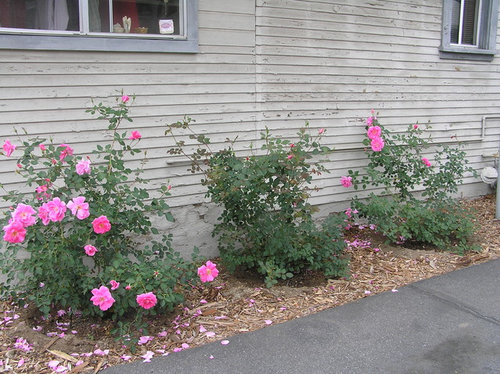
Carefree Beauty before torture--fall 2013. I stopped watering mid- June 2014, and plants were dry until the first soaking rain around Nov 1 .
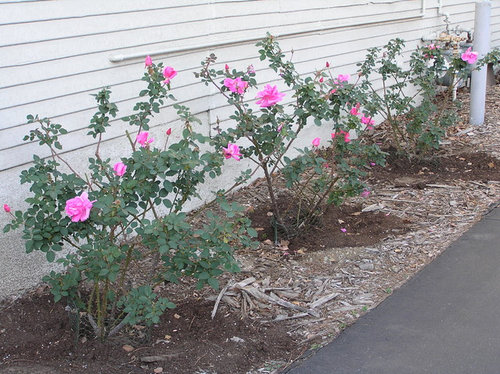
After torture, New Years Day 2015. Plants at this point were probably subject to unusually low Nitrogen conditions which may be the reason for the scant appearance. The amendment under the plants is very low in N. Or maybe they are scant because the framework branches should have been cut back more in fall, at the start of their growing season. Or their scantness may be a vestige of winter dormant ancestors in their lineage.
Thanks, Nate
Comments (55)
jerijen
9 years agoRosefolly Said: "In any case I definitely would not do this with young roses."
. . . and I agree with her. Even roses that will develop drought-tolerance with age/maturity are unlikely to have that tolerance as immature plants.raingreen
Original Author9 years agoThanks for all your replies. I'm expecting all roses grown like this to go dormant in summer, maybe defoliate. They would all have to be located in areas that absorbed water in winter but were well drained (retentive soil, next to a downspout etc) and would need supplemental watering in the very dry winters.
I think it's definitely a rule, only subject the roses to drought once-established. In my experience plants that are going through a youthful growth spurt (younger plants that are jumping into their mature size) will die if subjected to drought. This is true even for the real hardy Medit plants like Spurge Olive (Cneorum tricoccon).
Madgallica that's exactly right I had figured the cold hardy subtropical roses were a good potential source. I also am looking at the explorers but it'll be interesting to see if they flip seasons easily and grow upon the fall rains. Roses like Chireno (Carefree Beauty X Mutabilis) seem like the right combo of traits. Several of the pioneer roses are good winter bloomers in Zone 9 (according to Mike Shoup) but also cold hardy to Zone 4. Of course the disease pressure here in California is different than in Texas.
2 mentions of Mutabilis!! Thank you. Based on the educated guesses I've been making Mutabilis would have to be grown on north walls in the conditions I've described.
Anybody have experience with Grandma's Hat. Ragged Robin in the cold zones? Maybe I should post separately.
Thanks,Nate
jerijen
9 years agoIt's not the same issue -- but I was startled to see that, in Texas, 'Mutabilis' can completely defoliate from blackspot. I guess it gets new foliage later, but it is pretty awful looking, when it's going through the process.
Rosefolly
9 years agoI would also avoid hard pruning. The top structure of a plant is what supports the root structure, and you want the deepest, most robust roots you can get.
porkpal zone 9 Tx
9 years agoTexas A&M conducted a similar experiment to yours when they developed the Earth Kind rose designation. Your Carefree Beauty is one such rose as is Mutabilis. Have you tried other Earth Kind roses? Although not all cold hardy, they have all been tested to withstand drought.
jacqueline9CA
9 years agoI understand why you are looking at cold hardy roses, but will you be including warm climate roses which have proven that they are drought tolerant? Since you are talking about them growing in So Cal, it seems logical. I have a very old (for CA) house which has had a rose garden for 110 years (family). When we moved in, there were surviving tea roses in the garden which had not been given any summer water for 20+ years. They were thriving, but mostly bloomed in the Spring, and then again in the Fall. The three best were Le Vesuve, Anna Olivier, and Duchesse de Brababant. Once we started to give them summer irrigation, they started blooming 11 months of the year. Also there was a huge bush of Cecile Brunner which acted the same way. These roses were originally planted in the garden when it was actively gardened by my husband's ancestors, so they would have gotten water, etc. Then the house became a rental, and the garden was only minimally attended to for 20 + years. So, they fit with the model of established roses which were then summer drought tolerant. I am a bit confused about why you think mutabilis would have to be grown on a North wall - mutabilis loves sun and heat - what climate zone are you talking about in So Cal?
Jackie
User
9 years agoNate if you check the gardens tab on HMF you'll see that Grandma's Hat is much more present in Northern gardens than Gloire de rosomanes.
raingreen
Original Author9 years agoNot all roses look attractive when dormant I know. I am trying to find ones that look interesting e. g. bright hips, interesting color in stems, elegant branching habit. The one I am testing, Carefree Beauty, has an excellent hip display and personally I like the branching pattern.
Porkpal, right now, I'm only testing the one Earthkind rose, Carefree Beauty. Earth kind roses were tested in Texas conditions where rust and mildew aren't problems, so I would use the ones that were considered disease resistant locally. I understand the program did subject their roses to extreme conditions in the 2011 Texas drought, and they continued to do well. The polyantha Earth Kind Cecile Brunner I've found in near deserted conditions locally but I haven't confirmed that water was shut off in those locations.
Thanks for your tips rosefolly and rathersmallbunny!! And I know the larger the tops, the more hormones for the roots. And Grandma's Hat is cold hardy, just would like to know how much.
Jackie, a study on the Mediterranean island of Ibiza found that the Teas were not resilient in drought, partly because they weren't sun tolerant. I'm assuming that they meant the bare canes were susceptible to sunscald. The desert rose hybridizer Robert Rippetoe has also told me Teas as a group are susceptible to sunscald in his climate. Because tissue that is drought stressed can't withstand sunburn as well, I've assumed that the sunscald would reach near-epic proportions during the summer drought in my area, for the Teas. In the milder climate of northern California (exc/ the Central Valley) plant tissues would be less desiccated and experience somewhat lower temps and sunlight levels, enough perhaps to keep some foliage and/or resist scald.
Because my personal favorites are the Tea roses but I suspect I can't grow them in very dry gardens in my area, I've looked at Polyanthas like Cecile Brunner (esp. Spray Cecile Brunner and the climber because of the larger root systems) and other Tea hybrids like the Alister Clark rose Sunny South which is cane hardy to Zone 6a, according to an HMF comment. The virtue of the cold tolerant plants is they have sunscald tolerance in the winter when bare of leaves--when their tissue is frozen they can still withstand bright sun which heats tissue and causes moisture loss. When this characteristic is combined with heat tolerance, defined as ability to maintain physiological functions at high temperatures, that would mean that sunscald would likely be less of a problem during the summer. For many modern roses, an easy way to tell heat tolerance is the ability to maintain flower size during hot weather. I don't believe this is a good heat tolerance indicator for those Teas who are adapted to go to sleep when it's hot (like Safrano).
All of this is mostly still an educated guess altho Carefree Beauty showed no damage after last summer.
Thanks for the tip on Gloire, True Blue! Yes I was hoping against hope it was a cold zoner.
NateMelissa Northern Italy zone 8
9 years agoMy Teas do fine in drought (I think Rosefolly's comments are right on the mark) but they're mostly in part shade. Also I plant a lot of companion plants. I had that problem with sun scald with the Noisette 'Belle Vichyssoise' and am attempting to deal with it by putting a rosemary hedge at its feet. I hope this will protect the bare lower parts of the canes from sun while the upper part of the plant is sheltered by its own foliage.
jerijen
9 years agoTwo comments:
- I know someone who grows Grandmother's Hat in Wisconsin.
and - My biggest, oldest, most-beautiful Grandmother's Hat grows directly under, and in the shade of, a gigantic seedling avocado tree. My micro-climate is in the process of becoming hotter and dryer, and some of my best roses enjoy shade in that way.
- I know someone who grows Grandmother's Hat in Wisconsin.
raingreen
Original Author9 years agoMy best guess is that Teas would be fine down in drought down here as long as in part shade from June-September, and given good soil and good winter moisture. They probably wouldn't like being next to big trees, which suck up alot of water. It's important to realize that the proportion of soil taken up by rocks reduces the amount of water avail for plants. Also tilling in organic matter increases water availability for plants. I have no personal experience but there are plant sun screens like Purshade Ultra (calcium carbonate based, allows photosynthesis) or Surround WP crop protectant (kaolin based) (as long as good coating of white film remains, reapplication unnecessary) which can protect against sunscald, but not borers. Here in soCal we have Pacific flatheaded borers which are attracted to sunstressed plants and not infrequently HTs are damaged, as at the nonprofit I work at. I have no experience with the sun screens and it sounds like the kaolin-based would look messy. There actually are attractive shade structures that people use in the desert on succulent gardens. And like you suggested plants can be used as sunscreen.
Everyone should keep in mind I'm spouting off, I have only done the one initial test on Carefree Beauty, which isn't suited for California coastal areas because it can be a mildewer. Locally, the roses Graham Thomas and Evelyn can be grown without water once-established, according to Julianna Delgado, a professor at my college. Also, the landscape architect Trevor Nottle found established, healthy plants of Lady Ann Kidwell near the Watts Towers in Los Angeles, growing without water. I've seen wretched looking Icebergs growing against a north facing wall in an abandoned garden in Pasadena, where the city had shut off the water years earlier. But if the dry roses all look like the Icebergs did, it actually isn't worth it. Only if the plants are still enjoyable would I grow them dry.raingreen
Original Author9 years agoThanks Jeri, posted before I saw your comment. I think roses would be more drought resistant in part shade because of lower evapotranspiration.
Do you know if the Grandma's Hat is cane hardy or a dieback shrub in Winsconsin??jerijen
9 years agoForgive me!
She is in Minnesota.
She is a very dedicated Rosarians, and "tips" her tender roses.
SEE:
http://www.extension.umn.edu/garden/yard-garden/flowers/minnesota-tip-method-of-protecting-garden-roses/
or
http://www.bachmans.com/Garden-Care/divHomePage.html?cnb=GardenCare&categoryCode=02&pageIndex=_pageIndexToken_minnesotaTipMethodforRoses
or
http://www.rose.org/wp-content/uploads/2011/03/Winterizing-Roses-in-the-North-Central-District.pdfraingreen
Original Author9 years agoDo you think she tips Grandma's Hat? Doesn't seem likely. So it DOES grow in Zone 4. Thanks for this!!!!
jerijen
9 years agoShe has told me that she tips it. I'm sure it is smaller there, than it is here, but at least she can enjoy it.
User
9 years agolast modified: 9 years agoNate, FWIW R. spinosissima hybrids are some of the cold hardiest roses in Canada. They are drought tolerant and some especially the Dr. Skinner hybrids, are hard to come by. They have very interesting hips. Here is an interesting article by Peter Boyd, Scots Roses - past and present.
- Bob
raingreen
Original Author9 years agoThanks Bob, by some sort of strange luck I had found the article last night already?!
My personal goal was for roses that would grow and bloom upon the fall rains of the Mediterranean climate and I suspect the once blooming Scots would be dormant til February or March in soCal. Maybe the hybrids like 'Golden Wings' would be winter bloomers if given the summer dormancy, don't know.
Thanks!!! NateUser
9 years agoThere are many every-blooming hybrids, the most famous Stanwell Perpetual.
The problem with these roses are that they are rare & difficult to find....jacqueline9CA
9 years agoWhat about banksie lutea? It is very drought tolerant (I just went on a bike ride near a local college - they have literally dozens of them lining the bike path - no water whatever except winter rains). All are just coming into full bloom right now. They love hot weather - the largest rose in the world is a banksia which grows in Arizona. The yellow one (lutea) is also completely, truly, thornless. I have a mature banksia lutea growing on my house, and it starts blooming every WInter in Jan/Feb, and blooms until the normal "early blooming" roses start in April. Has some re-bloom in the Fall here.
Jackie
Tessiess, SoCal Inland, 9b, 1272' elev
9 years agoStanwell Perpetual is a beautiful rose here, blooming almost year round (own root from Heirloom--the clone from Rogue Valley was weak and failed to grow). Very drought tolerant and healthy. It is one of my favorite roses. I just got the hybrid spinosissima Suzanne. Very difficult rose to obtain. I had to hunt and wait. Mine just arrived as a baby band (own root from High Country Roses) and is now in a 1 gallon pot. Too early to say how well she will like it here and how much she will bloom, but other spinosissimas are excellent here. William's Double Yellow (grafteed on multiflora from Pickering) even rebloomed multiple times last year much to my surprise.
On Grandmother's Hat. What a beautiful rose in pictures and gorgeous when I saw her at the Stagecoach Inn (much closer to the coast than I am). I paid attention to the comments Ingrid made about this rose growing in her garden--not great in her hot, dry garden, and I think she removed GH. Mine came as an extremely tiny band which I didn't think would survive. Lots of pampering, and she did. But I put her in a very cool and shaded spot, the eastern side of my house in a fair amount of shade from a cedar tree. She is now approximately 5 1/2 to 6 feet tall. However, she is far from drought tolerant (particularly as compared to my other roses) and needs extra water in summer. She may be more drought tolerant than many hybrid teas, of which I grow few, and hopefully she will become better at handling summer heat in future.
I have the rugosa Polareis (grafted on multiflora from Pickering) planted about 5 feet from GH, and it is quite drought tolerant, like all my other rugosas except for one. One of my favorite roses is the rugosa Wild Edric (grafted on multiflora from Pickering). A stellar performer in heat and drought. Repeats well, healthy foliage, and quite happy with almost zero groceries. I just planted the beautiful rugosa Wasagaming which had arrived as a band in the fall from High Country Roses. Such a pretty rose. It is in a very tough spot in depleted soil but so far it seems happy. The rugosas are cold hardy and very low maintenance in my garden. Others that are thriving here are Snowden (own root from Heirloom, this rose has particularly beautiful very dark green foliage and snowy white flowers, climbs), Mrs. Doreen Pike (own root from Heirloom, has lovely silvery pink flowers), and Frau Dagmar Hastrup (own root from High Country Roses, is growing fast and has gorgeous pale pink single flowers--TOUGH AS NAILS!!!)
jerijen
9 years agoBut there, again, I caution -- and Jackie has said -- Even roses that are relatively drought-tolerant as very mature plants may well not have been so, as infants. And our best and most-beautiful Grandmother's Hat -- a real monster -- grows under the shade of an avocado tree -- where it has flourished for more than 20 years.
raingreen
Original Author9 years agoYes I love Stanwell Perpetual, although just in pictures. I think that could be a candidate for very dry gardens down here. Because roses in very dry conditions are smaller than normal it may end up being a dwarf though, with too small a root system to see through the summer. Definitely worth a try.
The rugosas are amazing, especially Wasagaming!!! WOW!! They would be candidates for very dry gardens, as found by the Ibiza study of drought tolerant roses. But for my personal designs I use the plants that are winter-active, because I feel they symbolize the Mediterranean climate. I know I didn't state that earlier, sorry for being irritating. I am using Rosa minutifolia in my student garden project on the Cal Poly campus.
Lady Banks was stunning down here this winter, some plants had hydrangea-like clusters littered over the vines. They are planted on the 210 freeway in my area without any care exc/ occasional watering. And I wish I had actually noted when they started blooming, they may have been continuous since ?late fall?? And they are still blooming. Based on what people have said the Lady Banks would be drought resistant enough once-established, as long as the site was reasonable otherwise. I would definitely use it.
Kippy
9 years agoHave you considered the once bloomers? Some have some rebloom or so they say. I realized come September that I had forgotten to water one of mine all summer
Melissa Northern Italy zone 8
9 years agoLet me put in my two cents' worth once again, though I'm not sure how applicable results in my garden are to California. I find it interesting that such different roses do well for California Melissa and myself. I can't grow Rugosas, R. hugonis, or most Spinosissimas. The Rugosas just don't grow. R. hugonis and the Spinosissimas are both massacred by cane girdler: all the roses in the garden suffer from it to some extent, but their canes can't handle the damage and break immediately. My impression is the ph of our soil is around neutral--I've never had it tested but chlorosis is not generally a problem--but it is very heavy and poor in organic matter, and the Rugosas, hugonis and Spinosissimas seem to take it worse than many others. In fairness I should add that the couple of Spinosissimas I've had were in bad places, though similarly placed roses of other kinds have done better. 'Fruhlingsduft' is pretty happy, but it's one of the few. R. hugonis, in a favorable position, was magnificent until cane girdler arrived.
raingreen
Original Author9 years agoKippy, I know a lot of the once bloomers are drought resistant (and would use them if a client wanted them) but they tend to leaf out in spring and my personal preference is for plants that leaf out upon the fall rains. That's just me though. I don't know what the actual differences in drought resistance would be, betw/ repeat and once bloomers.
nippstress - zone 5 Nebraska
9 years agoFor what it's worth, I do grow Grandmother's Hat (if that's what you're asking about) here in zone 5. It's pretty hardy for me most winters and keeps canes in an average year. It did die to the ground last winter when it was particularly harsh, so it's probably unreliable anything colder than zone 5.
Cynthia
raingreen
Original Author9 years agoThanks Cynthia, yes, that was my question. I am using the cane hardiness info as an estimate of desiccation tolerance.
You da best!! Been wanting to use Grandma's Hat in a very dry garden, now I'll test it.
Natejerijen
9 years agoIf you do that, Nate -- give it shade.
You see, it will bloom just fine in shade, and may not be as stressed. And remember that, even if it handles drought as a mature plant, it may well NOT do so as a baby. And it can take 2-3 years to mature.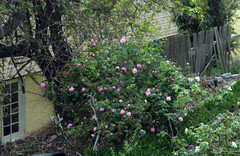
raingreen
Original Author9 years agoThat's lovely Jeri. I understand about the establishment phase. The site is in full sun, so maybe I should just try a couple of plants and see how it goes. I don't want to use the ornamental shade structures on the site--also can't afford it!!
nippstress - zone 5 Nebraska
9 years agoGlad to help, Nate. Just one more comment about drought and Grandmother's Hat for me. Mine is in my fullest sun bed at the back in scrubby poor soil area that gets little supplemental water because of its location. It survived even our drought two years ago, but I have to emphasize that full-sun Nebraska is not remotely like full sun California, and Nebraska drought can't hold anything to the dreadful and unending California drought. My results are certainly encouraging for you, but I think Jeri's suggestions for part shade are spot on for your California location, and she's been a tireless enabler of Grandmother's Hat as a good rose for California.
Regardless, she's a good one to experiment on once she gets well established enough not to need the extra water. In the first few weeks, if you have the option, you can rig up some temporary shade like a lawn chair set over the rose with earth staples to keep it down, or one of those small umbrellas tilted to keep off some of the sun and allow in the rain. That may not be feasible in this site, but it's certainly a low cost option to consider.Cynthia
raingreen
Original Author9 years agoThanks for the tips Cynthia. We have a native clematis on site, maybe I should weave one over the roses like in your garden.
Another fillip to any sort of experiment like this is the dry winters we've been having. I was assuming the roses would be getting a normal rainy season.
jerijen
9 years agoWe were ALL hoping for a normal rainy season. Now, I am really afraid that we are in something of a "new normal," and that is distressing. And challenging.
raingreen
Original Author9 years agoThat one period of rain in December was like a tonic but it really needed to keep on keepin' on. The good soak did effect some of the native plants--the native sages at my nonprofit flowered much better this spring than the last 2 years. I think it must have had something to do with the rain in December.
User
9 years agoNate, I came upon the Olds College rose gardens in Alberta. They grow some of the hardiest roses in Canada. Apparently they get only 35 cm (14") of annual rain.
If you download the brochure on this page you'll find their rose list. Some which you might be able to use for your experiment.
raingreen
Original Author9 years agoThanks for thinking of me. Going over their list. Looks like Stanwell Perpetual is a larger shrub in the north than I had thought (??) . N
User
9 years agoWell considering that its height is 6-8' according to HMF, hardy to zone 3, a mature specimen can become quite big, even in Alberta.....
Tessiess, SoCal Inland, 9b, 1272' elev
9 years agoWasagaming just starting to bloom yesterday with Salvia mellifera (black sage). Wasagaming arrived last September in a small pot (equivalent to a band in size) from High Country Roses. Unfortunately the weather suddenly rocketed upwards after this order shipped on a Monday, and UPS in its infinite wisdom decided rather than deliver the roses on Wednesday or Thursday (quite hot by then) to keep them in a boiling hot location over the weekend. Then put them on the truck on Monday and delivered them around 7pm. The box was still HOT!!!! Roses inside were in various degrees of cooked--think foliage either crispy or like steamed spinach. The 3 rugosas all defoliated but survived (Scabrosa, Frau Damar Hastrup, and Wasagaming). The 2 roses on the hotter side of the box had crispy leaves and died--R. pomifera and Suzanne. That extreme trial proved the toughness of these rugosas. I kept Wasagaming in a pot and fed with only diluted fish emulsion + regular garden water (very alkaline) from a hose. Planted in the ground earlier this month. No soil amendments nor mulch.

Wasagaming on March 13: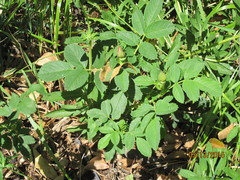
raingreen
Original Author9 years agoBased on what I've seen @ HMF I love Wasagaming, blooms in sheets. It's amazing how some roses have such a broad climate tolerance. Is your soil acid?
nikthegreek
9 years agoLet me chime in just to say that grafting a rose to an understock more suitable for the conditions can make a whole lot of difference. You guys in the States seem to love own root roses, there's certainly some sense in that, but every fruit tree farmer and his dog knows that when things get tough the (properly) grafted plants get going.... Indica major is the one commonly used but if I were a dedicated experimenter I would check out to see how fortuniana does in such conditions and, if I were to live 100 years, I would experiment with banksiae and sempervirens (a native Med macquis rose).
ingrid_vc so. CA zone 9
9 years agoAlthough it seems to be true that rugosas don't like extremely alkaline soil, the four Wild Edrics, which are rugosas that I bought on Melissa's advice are bright green after having been in the ground here for more than a year. Of course, they were not planted in strictly native soil, but then most roses aren't. There must be degrees of alkalinity depending on the composition of one's soil, and well-amended soil may well be able to support rugosas in southern California. The one thing I have notices with Wild Edric is that the blooms seem rather tender and floppy, and don't hold up for very long. I'm hopeful that maturity will have some effect on that. I must say that Mutabilis that I planted in full sun in other gardens nearby didn't seem terribly happy; in my climate they do appreciate some afternoon shade.
Tessiess, SoCal Inland, 9b, 1272' elev
9 years agoI think soil amendments and other care is more likely a problem, rather than alkalinity, in growing rugosas in Southern California. You are probably right Ingrid that most roses planted here are not planted in strictly native soil. But mine are because I want roses that like the natural conditions here. And from what I've read on rugosas, they like lean, sandy, fast draining soil. That is precisely what I have. Those that seem to get into trouble with rugosas (and some others such as Reine des Violettes--Jon in Wessex, England, grows his on chalk, which is ultra alkaline, without chlorosis) amend the soil, heavily mulch, fertilize often, and repeatedly add acidifiers to the soil. I've never used an acidifier to the soil for my roses. It is too alkaline to grow things such as blueberries (many in the neighborhood have tried unsuccessfully for years). But rugosas look fine. I have 9 different rugosas and none seem to have any trouble with the soil/conditions in my garden. Some are even grafted on multiflora (from Pickering, and that includes Wild Edric), which doesn't seem to matter. There is a theory that these roses do not to like alkaline soil, but I think this theory is flawed. I haven't had any problems, yet I don't do anything to prevent them.
Here's a photo of Wasagaming, in between Reine des Violettes and the hybrid tea Limelight. All are in very sandy, lean soil up close to, and in the root zone of a huge ash tree (trunk is around 4 feet in diameter). No soil amendments for any of them when planted. No mulch except what they get from the ash tree's leaves. Fed occasionally with diluted fish emulsion. Nothing else. Water from the garden hose. Surrounded by native California salvias which would not tolerate rich treatment.
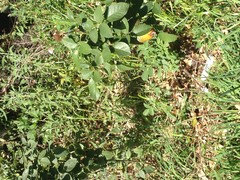
Sorry, this was a vertical picture and Houzz turned it sideways. RdV is at the bottom, the small plant in the middle with the white tag is Wasagaming, the green leaved rose at the top is Limelight.
Foliage on the rugosa Snowden (own root from Heirloom):
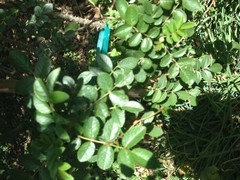
Foliage on the rugosa Polareis (grafted on multiflora from Pickering):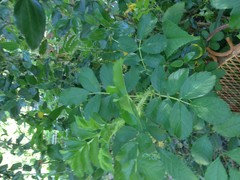
Foliage on the rugosa Frau Dagmar Hartopp (own root from High Country Roses), arrived September 2014 and was baked in shipment like Wasagaming. I have her in a tomato cage to protect from canine friends: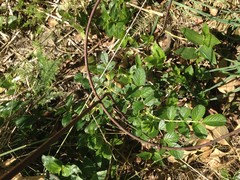
Foliage and blooms on the rugosa Wild Edric (grafted on multiflora from Pickering):
ingrid_vc so. CA zone 9
9 years agoI'm getting quite fond of my Wild Edrics. I'll be interested to see how they make it through the heat of summer and how much bloom production is affected. I really like the fact that there isn't the slightest sign of mildew on them since quite a few of my roses are affected with that malady right now.






rathersmallbunny